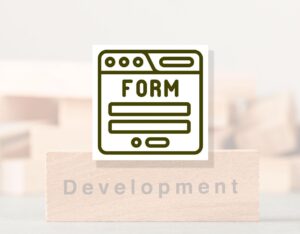How to Create e-Content Custom Contact Form Blocks
 Understanding e-Content Custom Contact Form Blocks
Understanding e-Content Custom Contact Form Blocks
A well-designed contact form is more than just a tool for collecting information; it’s a gateway to building relationships with potential clients, customers, or partners. This guide will walk you through the process of creating e-Content custom contact form blocks using Advanced Custom Fields (ACF), focusing on how you can enhance your website’s user experience without needing advanced coding skills.
Custom contact form blocks are powerful elements that allow you to tailor the way users interact with your website. Unlike standard, pre-built forms, custom contact form blocks offer the flexibility to design forms that align perfectly with your brand’s needs and aesthetic.
The Custom Contact Forms Block In Action
Why Custom Contact Forms Matter
- Improved User Experience: Custom contact forms are designed with your audience in mind, ensuring that every element is optimized for ease of use. A well-structured contact form reduces friction, making it easier for users to get in touch with you.
- Brand Consistency: By creating custom contact form blocks, you can ensure that your forms reflect your brand’s identity, from color schemes to fonts and layout. Consistent branding across your website reinforces your brand message and helps build trust with your audience.
- Enhanced Functionality: Custom contact forms allow you to add specific fields relevant to your business, such as dropdown menus, checkboxes, and radio buttons. This added functionality enables you to collect more accurate and useful data from your users.
- Increased Conversion Rates: When users find it easy and intuitive to reach out to you, the likelihood of conversion increases. A well-optimized custom contact form can lead to higher response rates and more meaningful interactions with potential clients.
Use Cases for Custom Contact Form Blocks
Custom contact form blocks can be utilized in various ways to enhance your website’s interactivity and functionality:
- Service Inquiries: Create tailored forms that allow potential clients to specify the services they are interested in, making it easier for your team to provide relevant information and quotes.
- Customer Support: Custom forms designed specifically for customer support inquiries can streamline the process of gathering necessary information, ensuring faster and more efficient responses.
- Event Registrations: Use custom forms to manage event sign-ups, with fields for attendees to select sessions, dietary preferences, or payment options.
- Surveys and Feedback: Collect valuable feedback or conduct surveys directly through custom forms, helping you gather insights that can improve your products or services.
The Role of ACF in Creating Custom Contact Form Blocks
Advanced Custom Fields (ACF) is an indispensable tool for creating custom contact form blocks. ACF allows you to build and manage custom fields on your WordPress site, providing the flexibility to design forms that perfectly match your needs.
Benefits of Using ACF for Custom Contact Form Blocks
- Flexibility: ACF offers a range of field types, from text and email inputs to more complex fields like checkboxes and dropdowns. This versatility allows you to create forms that collect exactly the information you need.
- Ease of Use: Even non-technical users can create and manage custom contact forms with ACF’s intuitive interface. The plugin simplifies the process, making it accessible to those without coding experience.
- Integration: ACF integrates seamlessly with WordPress, meaning you can create custom forms that blend seamlessly with your site’s design. The forms you create will look professional and consistent with the rest of your content.
- Scalability: As your website grows, ACF allows you to easily add new fields or modify existing ones, ensuring your contact forms can evolve alongside your business needs.
Step-by-Step Guide to Creating e-Content Custom Contact Form Blocks
Creating a custom contact form block using ACF involves several straightforward steps. Here’s a quick guide to get you started:
Step 1: Install and Activate the ACF Plugin
1.1 Install ACF:
- Access your WordPress dashboard, navigate to the Plugins section, and search for Advanced Custom Fields.
- Install and activate the plugin.
1.2 Configure ACF:
- After activation, familiarize yourself with the ACF interface. You’ll use it to create and manage the fields for your contact form.
Step 2: Create a Custom Field Group
2.1 Define a New Field Group:
- Navigate to the Custom Fields section and click on Add New.
- Name your field group something relevant, like “Contact Form Fields.”
2.2 Set Up Fields:
- Within this group, start adding the necessary fields (e.g., Name, Email, Message).
- Choose appropriate field types, such as Text for the name, Email for contact information, and Text Area for the message.
Step 3: Configure Field Settings
3.1 Field Details:
- For each field, enter a label (the name that will appear on the form) and any instructions or placeholder text.
3.2 Validation Rules:
- Set validation rules, like required fields or email format validation, to ensure the form collects the correct data.
Step 4: Implement the Contact Form Block
4.1 Insert the Custom Block:
- Use the WordPress Block Editor to add the custom contact form block to the desired page or post.
- Customize the block’s appearance to align with your site’s design.
4.2 Preview and Test:
- Before publishing, preview the form on your site to ensure it displays correctly and functions as expected.
- Test all fields to verify data submission and validation.
Step 5: Publish and Monitor
5.1 Publish the Form:
- Once you’re satisfied with the setup, publish the page or post containing the contact form.
5.2 Monitor and Optimize:
- After publishing, regularly monitor the form’s performance. Check for any issues in form submissions and gather feedback from users.
- Use insights gained from user interactions to make adjustments and improve the form’s usability over time.
Best Practices for Creating Effective e-Content Custom Contact Form Blocks
To maximize the effectiveness of your custom contact form blocks, adhere to the following best practices:
Optimize for User Experience
- Keep It Simple:
- Avoid overwhelming users with too many fields. Only ask for essential information to make the process quick and easy.
- Use Clear Labels:
- Ensure that all fields are clearly labeled so that users understand exactly what information is required. This minimizes confusion and reduces the likelihood of incomplete submissions.
- Provide Inline Validation:
- If possible, incorporate real-time validation that informs users immediately if they’ve made an error. This improves the overall user experience by allowing them to correct mistakes before submitting the form.
Ensure Accessibility
- Make It Mobile-Friendly:
- With a growing number of users accessing websites via mobile devices, ensure that your contact forms are fully responsive and easy to navigate on smaller screens.
- Support Keyboard Navigation:
- Your forms should be fully navigable using just a keyboard, which is crucial for accessibility. Ensure that all form fields can be accessed and filled out using the tab key.
- Add ARIA Labels:
- Use ARIA (Accessible Rich Internet Applications) labels to help screen readers accurately interpret the form fields for visually impaired users.
Enhance Functionality
- Conditional Logic:
- Implement conditional logic to show or hide fields based on user responses. This keeps the form relevant to the user and can help reduce the number of fields they need to fill out.
- Automated Responses:
- Set up automated response emails to confirm that a user’s submission has been received. This reassures users that their message has been successfully delivered.
- Integration with CRM Tools:
- Integrate your contact forms with Customer Relationship Management (CRM) tools to automatically collect and organize data for future follow-up.
Optimize for SEO
- Include Relevant Keywords:
- Make sure that your form titles and descriptions include relevant keywords like “Creating e-Content Contact Form Blocks” and “ACF Custom Contact Form Blocks for e-Content.” This helps improve your website’s visibility on search engines.
- Add Meta Descriptions:
- Each page containing a custom contact form block should have a well-crafted meta description that includes your target keywords to attract more clicks from search engine results.
- Monitor Performance:
- Use tools like Google Analytics to track how users interact with your forms. Analyze metrics like form submission rates and abandonment rates to identify areas for improvement.
Advanced Customization Tips
For those looking to further enhance their custom contact form blocks, consider these advanced tips:
Integrate Third-Party Services
- Email Marketing Integration:
- Connect your contact forms with email marketing services like Mailchimp or Constant Contact. This allows you to automatically add new contacts to your mailing lists and manage email campaigns more efficiently.
- Zapier Automations:
- Use Zapier to create automations that link your contact form submissions to other services, such as Slack for team notifications or Trello for task management.
Enhance Security
- Implement reCAPTCHA:
- Protect your forms from spam and abuse by integrating Google reCAPTCHA. This simple addition helps ensure that only genuine submissions are received.
- Encrypt Data:
- Ensure that all data submitted through your forms is encrypted, especially if you’re collecting sensitive information. This enhances the security of your website and builds trust with users.
Conclusion
Creating e-content custom contact form blocks is a powerful way to enhance your website’s functionality and user experience. By using tools like Advanced Custom Fields (ACF), you can design forms that are not only visually appealing but also highly effective in capturing the information you need from your visitors.
By following the steps and best practices outlined in this guide, you can create custom contact form blocks that align with your brand’s identity and meet your business needs. Whether you’re gathering service inquiries, managing event registrations, or collecting customer feedback, these custom forms will help you achieve your goals while providing a seamless experience for your users.
Remember, the key to success is not just in the creation of these forms but in their ongoing optimization. Regularly monitor their performance, gather user feedback, and make adjustments as needed to ensure that your contact forms continue to serve your business effectively in the ever-evolving digital landscape.






